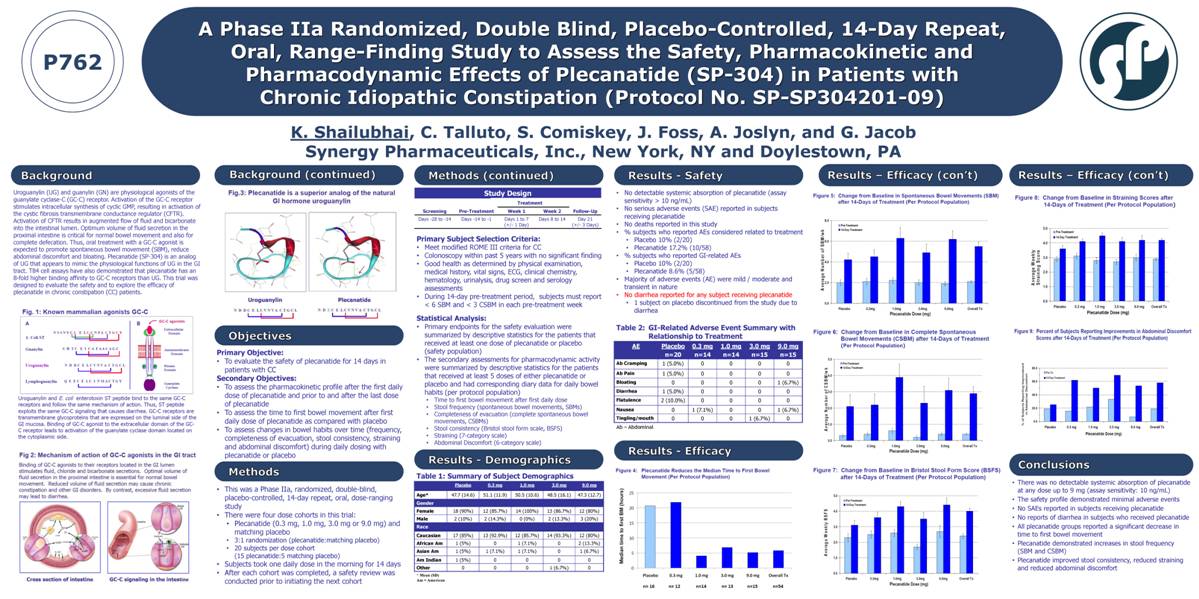Attached files
| file | filename |
|---|---|
| 8-K - 8-K - SYNERGY PHARMACEUTICALS, INC. | a11-23405_28k.htm |
Exhibit 99.1

A Phase IIa Randomized, Double Blind, Placebo-Controlled, 14-Day Repeat, Oral, Range-Finding Study to Assess the Safety, Pharmacokinetic and Pharmacodynamic Effects of Plecanatide (SP-304) in Patients with Chronic Idiopathic Constipation Protocol No. SP304201-09) A Phase IIa Randomized, Double Blind, Placebo-Controlled, 14-Day Repeat, Oral, Range-Finding Study to Assess the Safety, Pharmacokinetic and Pharmacodynamic Effects of Plecanatide (SP-304) in Patients with Chronic Idiopathic Constipation (Protocol No. SP-SP304201-09) P762 K. Shailubhai, C. Talluto, S. Comiskey, J. Foss, A. Joslyn, and G. Jacob Synergy Pharmaceuticals, Inc., New York, NY and Doylestown, PA Uroguanylin (UG) and guanylin (GN) are physiological agonists of the guanylate cyclase-C (GC-C) receptor. Activation of the GC-C receptor stimulates intracellular synthesis of cyclic GMP, resulting in activation of the cystic fibrosis transmembrane conductance regulator (CFTR). Activation of CFTR results in augmented flow of fluid and bicarbonate into the intestinal lumen. Optimum volume of fluid secretion in the proximal intestine is critical for normal bowel movement and also for complete defecation. Thus, oral treatment with a GC-C agonist is expected to promote spontaneous bowel movement (SBM), reduce abdominal discomfort and bloating. Plecanatide (SP-304) is an analog of UG that appears to mimic the physiological functions of UG in the GI tract. T84 cell assays have also demonstrated that plecanatide has an 8-fold higher binding affinity to GC-C receptors than UG. This trial was designed to evaluate the safety and to explore the efficacy of plecanatide in chronic constipation (CC) patients. Background continued) Objectives Primary Objective: •To evaluate the safety of plecanatide for 14 days in patients with CC Secondary Objectives: •To assess the pharmacokinetic profile after the first daily dose of plecanatide and prior to and after the last dose of plecanatide •To assess the time to first bowel movement after first daily dose of plecanatide as compared with placebo •To assess changes in bowel habits over time (frequency, completeness of evacuation, stool consistency, straining and abdominal discomfort) during daily dosing with plecanatide or placebo Methods •This was a Phase IIa, randomized, double-blind, placebo-controlled, 14-day repeat, oral, dose-ranging study •There were four dose cohorts in this trial: •Plecanatide (0.3 mg, 1.0 mg, 3.0 mg or 9.0 mg) and matching placebo •3:1 randomization (plecanatide:matching placebo) •20 subjects per dose cohort (15 plecanatide:5 matching placebo) •Subjects took one daily dose in the morning for 14 days •After each cohort was completed, a safety review was conducted prior to initiating the next cohort Study Design Treatment Screening Pre-Treatment Week 1 Week 2 Follow-Up Days -28 to -14 Days -14 to -1 Days 1 to 7 (+/- 1 Day) Days 8 to 14 Day 21 (+/- 3 Days) Primary Subject Selection Criteria: •Meet modified ROME III criteria for CC •Colonoscopy within past 5 years with no significant finding •Good health as determined by physical examination, medical history, vital signs, ECG, clinical chemistry, hematology, urinalysis, drug screen and serology assessments •During 14-day pre-treatment period, subjects must report < 6 SBM and < 3 CSBM in each pre-treatment week Statistical Analysis: •Primary endpoints for the safety evaluation were summarized by descriptive statistics for the patients that received at least one dose of plecanatide or placebo (safety population) •The secondary assessments for pharmacodynamic activity were summarized by descriptive statistics for the patients that received at least 5 doses of either plecanatide or placebo and had corresponding diary data for daily bowel habits (per protocol population) •Time to first bowel movement after first daily dose •Stool frequency (spontaneous bowel movements, SBMs) •Completeness of evacuation (complete spontaneous bowel movements, CSBMs) •Stool consistency (Bristol stool form scale, BSFS) •Straining (7-category scale) •Abdominal Discomfort (6-category scale) Results - Demographics Table 1: Summary of Subject Demographics Placebo 0.3 mg 1.0 mg 3.0 mg 9.0 mg Age* 47.7 (14.6) 51.1 (11.9) 50.5 (10.6) 48.5 (16.1) 47.3 (12.7) Gender Female 18 (90%) 12 (85.7%) 14 (100%) 13 (86.7%) 12 (80%) Male 2 (10%) 2 (14.3%) 0 (0%) 2 (13.3%) 3 (20%) Race Caucasian 17 (85%) 13 (92.9%) 12 (85.7%) 14 (93.3%) 12 (80%) African Am 1 (5%) 0 1 (7.1%) 0 2 (13.3%) Asian Am 1 (5%) 1 (7.1%) 1 (7.1%) 0 1 (6.7%) Am Indian 1 (5%) 0 0 0 0 Other 0 0 0 1 (6.7%) 0 * Mean (SD) Am = American Safety •No detectable systemic absorption of plecanatide (assay sensitivity > 10 ng/mL) •No serious adverse events (SAE) reported in subjects receiving plecanatide •No deaths reported in this study •% subjects who reported AEs considered related to treatment •Placebo 10% (2/20) •Plecanatide 17.2% (10/58) •% subjects who reported GI-related AEs •Placebo 10% (2/20) •Plecanatide 8.6% (5/58) •Majority of adverse events (AE) were mild / moderate and transient in nature •No diarrhea reported for any subject receiving plecanatide •1 subject on placebo discontinued from the study due to diarrhea Table 2: GI-Related Adverse Event Summary with Relationship to Treatment AE Placebo n=20 0.3 mg n=14 1.0 mg n=14 3.0 mg n=15 9.0 mg n=15 Ab Cramping 1 (5.0%) 0 0 0 0 Ab Pain 1 (5.0%) 0 0 0 0 Bloating 0 0 0 0 1 (6.7%) Diarrhea 1 (5.0%) 0 0 0 0 Flatulence 2 (10.0%) 0 0 0 0 Nausea 0 1 (7.1%) 0 0 1 (6.7%) Tingling/mouth 0 0 0 1 (6.7%) 0 Ab = Abdominal Efficacy – con’t) con’t)•There was no detectable systemic absorption of plecanatide at any dose up to 9 mg (assay sensitivity: 10 ng/mL) •The safety profile demonstrated minimal adverse events •No SAEs reported in subjects receiving plecanatide •No reports of diarrhea in subjects who received plecanatide •All plecanatide groups reported a significant decrease in time to first bowel movement •Plecanatide demonstrated increases in stool frequency (SBM and CSBM) •Plecanatide improved stool consistency, reduced straining and reduced abdominal discomfort Conclusions
